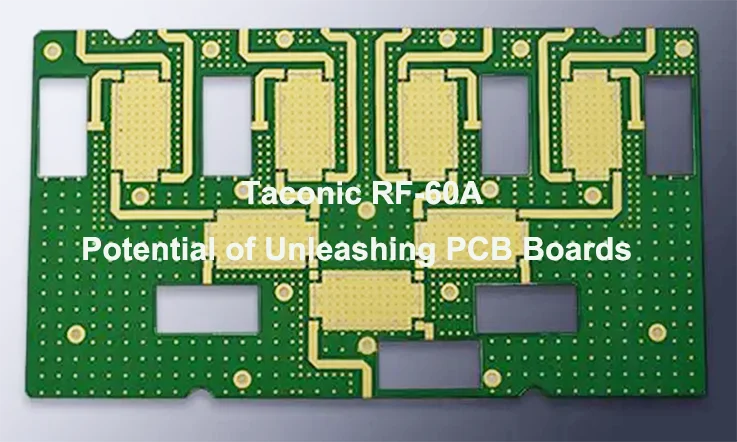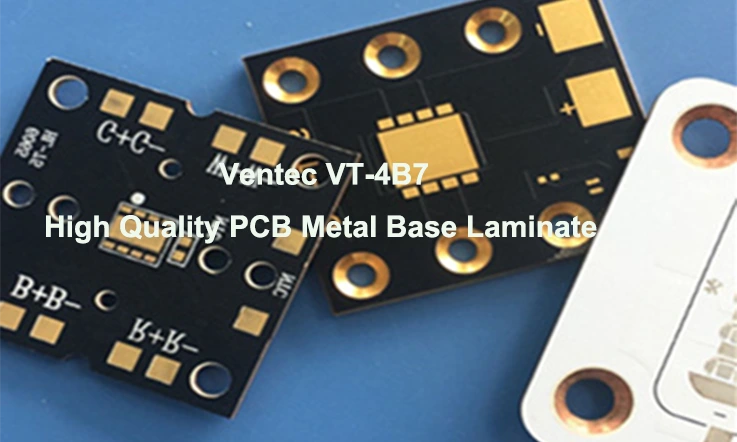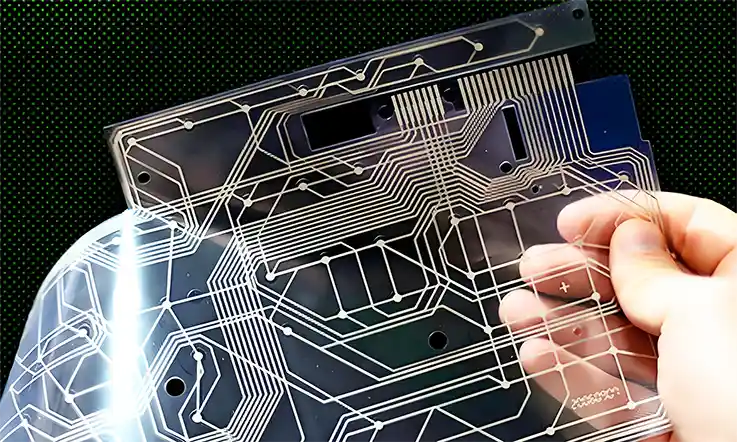
As electronic design engineers strive to meet the demands of high-frequency applications, the choice of PCB materials becomes crucial. Taconic RF-60A PCB materials have emerged as a go-to solution, offering exceptional performance and reliability. In this article, we explore the unique attributes of RF-60A laminates from the perspective of electronic design engineers, highlighting its benefits and applications.
What is Taconic RF-60A?
RF-60A is a high-performance organic ceramic fiberglass reinforced laminate, known for its low moisture absorption and consistent electrical properties. The woven fiberglass reinforcement of RF-60A ensures excellent dimensional stability, enhanced flexural strength, and minimal Z-axis expansion, making it ideal for use in extreme thermal environments and ensuring reliable plated-through-hole connections. Additionally, RF-60A boasts exceptional interlaminar bond strength and solder resistance.
Taconic is a global leader in the production of RF laminates and high-speed digital materials, offering a diverse range of high-frequency laminates and prepregs. These advanced materials are widely utilized in the manufacturing of antennas, multilayer RF and high-speed digital boards, interconnections, and devices.
Benefits of Taconic RF-60A PCB Materials
The Taconic RF-60A PCB material offers numerous benefits for engineers and manufacturers.
Advantages of Taconic RF-60A PCB Materials:
1.Remarkably Low Moisture Absorption:
Taconic RF-60A PCB materials exhibit an impressive resistance to moisture absorption. This characteristic ensures the long-term reliability and performance of the printed circuit boards by minimizing the adverse effects caused by moisture.
2.Consistent Dielectric Constant (Dk) Across Frequencies:
The Dk of Taconic RF-60A remains stable over a wide range of frequencies. This attribute is crucial for maintaining signal integrity and avoiding any distortions or variations in the electrical properties of the PCB, thus enhancing its overall performance.
3.Excellent Dimensional Stability:
Taconic RF-60A demonstrates exceptional dimensional stability, ensuring that the printed circuit boards retain their intended shape and size even under challenging operating conditions. This stability is vital for precise assembly and successful integration of components.
4.Minimal Z-Axis Expansion:
With low Z-axis expansion, Taconic RF-60A PCB materials limit the potential for issues arising from thermal stress. By minimizing expansion in the vertical direction, these materials offer enhanced reliability and reduce the risk of delamination or mechanical failures.
5.High Flexural Strength:
Taconic RF-60A possesses remarkable flexural strength, making it highly resistant to bending or deformation. This robustness enables the PCBs to withstand various mechanical stresses encountered during handling, assembly, and operation, ensuring their longevity and durability.
6.Exceptional Interlaminar Bonds:
The interlaminar bonds in Taconic RF-60A PCB materials are exceptionally strong. This characteristic ensures reliable adhesion between layers, preventing delamination and maintaining the structural integrity of the boards, even in demanding environments.
7.Compliance with ROHS & WEEE Regulations:
Taconic RF-60A PCB materials are fully compliant with the Restriction of Hazardous Substances (ROHS) and Waste Electrical and Electronic Equipment (WEEE) regulations. This compliance underscores their environmental friendliness and adherence to global standards concerning the use of hazardous substances in electronic products.
By leveraging the benefits offered by Taconic RF-60A PCB materials, engineers can design and manufacture highly reliable and high-performance printed circuit boards that meet the stringent demands of modern electronic applications.
Applications of Taconic RF-60A
Taconic RF-60A finds extensive applications in various electronic components and systems. Here are some notable uses:
1. Power Amplifiers: Taconic RF-60A is well-suited for power amplifier applications. Its low moisture absorption, dimensional stability, and exceptional interlaminar bonds ensure reliable performance even in high-power and high-temperature environments. The material’s low Z-axis expansion also helps maintain signal integrity and prevent thermal stress-related issues.
2. Filters & Couplers: Taconic RF-60A is an excellent choice for designing filters and couplers. Its stable dielectric constant (Dk) over a wide frequency range ensures consistent electrical characteristics, allowing for accurate signal filtering and coupling. The material’s high flexural strength and dimensional stability contribute to the reliable operation of these components.
3. Passive Components: Taconic RF-60A is suitable for various passive components such as capacitors, inductors, and resistors. Its exceptional interlaminar bonds and dimensional stability enable precise component integration and assembly, ensuring optimal performance and long-term reliability.
4. Antennas: Taconic RF-60A is commonly used in antenna designs. Its stable Dk over frequency and low moisture absorption help maintain the antenna’s performance in different environmental conditions. The material’s dimensional stability and high flexural strength support the fabrication of robust antenna structures, allowing for reliable signal transmission and reception.
By utilizing Taconic RF-60A in these applications, engineers can benefit from its excellent electrical properties, mechanical strength, and reliability, ultimately enhancing the performance and durability of the electronic components and systems they develop.
Why Some PCB designs Need Taconic RF-60A PCB Materials
Some PCB designs may require Taconic RF-60A PCB materials for several reasons:
1.High-Frequency Applications:
Taconic RF-60A is specifically designed for high-frequency applications. It offers stable electrical properties over a wide range of frequencies, ensuring consistent signal integrity and minimizing losses. This makes it suitable for circuits operating in the RF and microwave frequency ranges.
2.Low Loss and High Performance:
RF-60A laminates have low dielectric loss, which means they exhibit minimal signal attenuation. This characteristic is crucial for high-performance circuits that require efficient signal transmission and minimal signal degradation. RF-60A helps maintain the integrity and quality of high-frequency signals.
3.Controlled Impedance:
For circuits that require controlled impedance, such as high-speed digital or RF circuits, RF-60A laminates provide consistent and predictable electrical characteristics. This allows for precise impedance matching and impedance control, ensuring optimal signal propagation and minimizing reflections.
4.High Power Applications:
Taconic RF-60A laminates offer high thermal conductivity and excellent thermal dissipation properties. This makes them suitable for high-power applications where heat management is critical. The laminates can effectively dissipate heat generated by power components, preventing overheating and ensuring overall circuit reliability.
5.Dimensional Stability:
RF-60A laminates exhibit excellent dimensional stability, meaning they maintain their shape and size under varying environmental conditions, temperature changes, and mechanical stress. This stability is important for precise assembly, accurate component placement, and reliable interconnection.
6.Reliability and Durability:
Taconic RF-60A laminates are engineered to provide exceptional reliability and durability. They have high flexural strength, resistance to moisture absorption, and exceptional interlaminar bonding. These qualities help ensure long-term performance and reduce the risk of delamination, warping, or mechanical failures.
7.Compliance with Industry Standards:
Taconic RF-60A PCB materials comply with industry standards and regulations, such as ROHS and WEEE. This makes them suitable for applications that require adherence to environmental and safety standards.
Cost and Lead Time for RF-60A PCB Manufacturing
The use of RF-60A to manufacture circuit boards can be relatively expensive and lead to longer lead times due to several factors:
1. Specialized Material: RF-60A is a specialized high-frequency laminate material designed specifically for RF and microwave applications. Its unique properties, such as low loss, controlled impedance, and high thermal conductivity, make it well-suited for demanding applications. However, the specialized nature of the material and its manufacturing processes can result in higher material costs compared to standard PCB materials.
2. Limited Availability: RF-60A may have limited availability compared to more commonly used PCB materials. The production capacity for RF-60A laminates may be lower, leading to longer lead times for sourcing the material. Limited availability can also contribute to higher material costs.
3. Manufacturing Complexity: RF-60A laminates require specialized manufacturing techniques and processes to ensure the desired electrical and mechanical properties. The fabrication of RF-60A circuit boards often involves additional steps, such as precise impedance control, tighter tolerances, and more stringent quality control measures. These factors increase the complexity of the manufacturing process, leading to additional time and cost requirements.
4. Quality Assurance: Due to the critical nature of high-frequency applications, manufacturers of RF-60A circuit boards often implement rigorous quality assurance measures. This includes extensive testing and inspection to ensure the boards meet the specified electrical characteristics and performance requirements. The additional quality assurance steps can contribute to longer lead times and increased costs.
5. Specialized Expertise: Designing and manufacturing RF-60A circuit boards requires specialized knowledge and expertise in high-frequency design and fabrication. The availability of experienced engineers and technicians with the necessary skills and knowledge can impact the lead time and cost of manufacturing RF-60A boards.
It’s worth noting that the cost and lead time associated with using RF-60A for circuit board manufacturing can vary depending on factors such as the complexity of the design, board size, quantity, and the specific requirements of the application. Working closely with experienced JarnisTech PCB manufacturers and suppliers specializing in RF materials can help optimize the cost and lead time while ensuring the desired performance and quality of the RF-60A circuit boards.
How to Use RF-60A Laminates Fabrication a Circuit Board?
To fabricate a circuit board using RF-60A laminates, you can follow these general steps:
1. Design the Circuit: Begin by designing the circuit board layout using a PCB design software. Consider the specific requirements of your application and the electrical characteristics of RF-60A laminates to optimize the design.
2. Material Selection: Choose RF-60A laminates as the base material for your circuit board. Ensure that the laminate thickness and copper foil thickness are suitable for your design requirements.
3. Stack-up Design: Determine the number of layers and their arrangement in the stack-up. Consider factors such as signal integrity, power distribution, and impedance control. RF-60A laminates can be used for single-sided, double-sided, or multilayered boards.
4. Prepare the Substrate: Cut the RF-60A laminate sheets to the desired board size using appropriate tools like shears or a CNC machine. Ensure the dimensions match your design requirements.
5. Clean the Substrate: Thoroughly clean the RF-60A laminate sheets to remove any dust, dirt, or contaminants using a suitable cleaning agent. This step is crucial to ensure proper adhesion and bonding during the lamination process.
6. Apply Copper Foil: Laminate the RF-60A sheets with copper foil by using a laminator or press. Follow the manufacturer’s guidelines for temperature, pressure, and lamination duration. Ensure proper alignment of the copper foil with the laminate surface.
7. Etch the Copper: Apply a protective mask or resist to the copper foil and use an etching process to remove the excess copper, leaving behind the desired copper traces and patterns according to your circuit design.
8. Drill Holes: Use a precision drill machine to create holes for component mounting and interconnection. The holes should be drilled at the appropriate locations as per the design specifications.
9. Add Surface Finish: Apply a suitable surface finish to protect the copper traces and pads from oxidation and ensure good solderability. Common surface finishes include HASL (Hot Air Solder Leveling), ENIG (Electroless Nickel Immersion Gold), or OSP (Organic Solderability Preservative).
10. Solder Components: Place and solder the electronic components onto the prepared circuit board using appropriate soldering techniques such as through-hole or surface mount assembly. Ensure proper component alignment and solder joint quality.
11. Testing and Inspection: Perform electrical testing, such as continuity checks, to verify the functionality of the fabricated circuit board. Conduct visual inspection to ensure the overall quality of the board, including solder joints, component placement, and trace integrity.
12. Assembly and Integration: Once the circuit board passes testing and inspection, integrate it into the desired electronic system or product, following the specific assembly and integration procedures.
It’s important to note that the above steps provide a general overview of fabricating a circuit board using RF-60A laminates. The actual process may vary depending on the specific requirements, design complexity, and equipment available.
How to Test Quality for RF-60A PCB Board?
When testing an RF-60A PCB board, it’s important to ensure that the board meets the desired specifications and performs as expected in high-frequency applications. Here are some common testing methods and considerations for RF-60A PCB boards:
1.Visual Inspection:
Perform a visual inspection of the PCB board to check for any physical defects, such as soldering issues, component misalignment, or traces that may be damaged or improperly connected. Ensure that all components are securely mounted and that there are no obvious manufacturing or assembly errors.
2.Continuity and Connectivity Tests:
Use a multimeter or continuity tester to verify the continuity of traces, vias, and interconnections on the PCB. Check for open circuits, short circuits, or incorrect connections that could affect signal flow or disrupt the functionality of the board.
3.Impedance Testing:
Impedance testing is essential for RF circuits that require controlled impedance. Use a vector network analyzer (VNA) or impedance analyzer to measure the impedance characteristics of the transmission lines, traces, and connectors on the PCB. Compare the measured values with the design specifications to ensure proper impedance matching and signal integrity.
4.Signal Integrity Analysis:
Use an oscilloscope or spectrum analyzer to analyze the quality and integrity of signals on the PCB. Check for any signal distortions, reflections, or excessive noise that could degrade the performance of the RF circuit. Verify that the signals meet the desired frequency response and exhibit the expected waveform characteristics.
5.RF Performance Testing:
If possible, perform RF performance testing using appropriate test equipment. This may include measuring parameters such as insertion loss, return loss, gain, noise figure, and frequency response. Compare the measured values with the expected performance specifications to ensure that the RF circuit is operating within the desired limits.
6.Thermal Testing:
If the PCB board is expected to handle high-power or high-temperature applications, consider conducting thermal testing. Monitor the temperature of critical components or areas on the board using thermal imaging or thermocouples. Ensure that the board remains within safe operating temperatures to prevent thermal issues that could affect performance or reliability.
7.Environmental Testing:
Depending on the intended application, consider subjecting the PCB board to environmental tests. This may include temperature cycling, humidity testing, vibration testing, or thermal shock testing. Such tests help assess the board’s resistance to environmental conditions and ensure its reliability in real-world operating environments.
8.Compliance Testing:
If the PCB board needs to meet specific industry standards or regulations, perform compliance testing accordingly. This may involve verifying compliance with standards such as ROHS, EMC/EMI, or specific safety requirements.
Conclusion
In the realm of high-frequency circuit design, Taconic RF-60A PCB materials shine as a top-tier choice for engineers. With their low loss, controlled impedance, and thermal management capabilities, RF-60A laminates empower designers to achieve superior signal integrity and optimal performance. As the demand for high-frequency applications continues to grow, RF-60A materials stand as a trusted ally for electronic design engineers, enabling the development of cutting-edge solutions in wireless communication, radar systems, and beyond.





